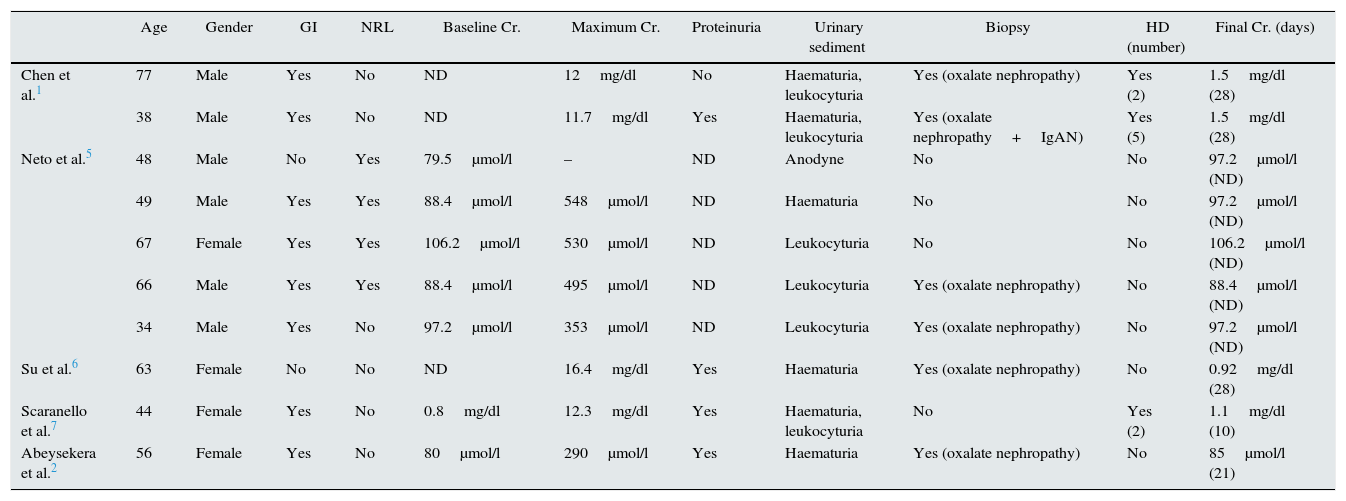Star fruit, or carambola (Averrhoa carambola), belongs to the Oxalidaceae family, which is shown in Fig. 1. This fruit is commonly consumed in Asia and Latin America, although with globalisation it is easy to find it in any country across the world. Numerous therapeutic properties have been attributed to it, however carambola is rich in oxalic.1–3 In patients with chronic kidney disease, the consumption of star fruit is associated to neurological symptoms that can range from hiccups and confusion to coma and death.2,4 Despite their widespread consumption, there are only about ten cases reported of acute kidney injury (AKI) secondary to carambola consumption.1,2,5–8 Here we present a new case of AKI caused by carambola consumption.
The patient is 55-year-old female from Peru with a personal medical history of smoking, hypertension treated with dietary measures, type II diabetes mellitus controlled with 2 oral antidiabetics, and dyslipidaemia treated with a statin. She went to the emergency room because of low back pain on both sides, with nausea, abdominal pain and asthenia. The physical examination showed blood pressure of 140/80mmHg, mild mucocutaneous dehydration, and pain on palpation of both kidneys areas, with no pain reaction to percussion in both sides. Laboratory test results were: haemoglobin 13.6g/dl, WBC 8300/μl, serum creatinine 4.55mg/dl, urea 113mg/dl, sodium 143mEq/l, potassium 5.1mEq/l, pH 7.30, pCO2 37mmHg and HCO3 18mmol/l. In urine the results were: sodium 36mEq/l, potassium 31mEq/l, creatinine 101mg/dl and proteinuria 20mg/dl. The urine sediment presented limited bacteriuria, crystals of amorphous urates, 5 WBC and 2 RBC per field. The patient was admitted to the internal medicine service, with an initial diagnosis of possible acute pyelonephritis. However, despite empiric antibiotic therapy with ceftriaxone and intensive serum therapy, renal function did not improve, and so consultation to the nephrology department was requested. Many studies were performed during admission (autoimmunity, viral serology, proteinogram and thyroid profile), with no abnormalities. The ultrasound showed enlarged kidneys (14.8cm on the right and 14cm on the left), with no other findings.
On a second interrogation, the patient admitted to have felt confusion, awkwardness, dizziness, low back pain, abdominal pain and nausea 2h after a large intake of 2–3 glasses of “carambola” juice, while the patient was fasting. Reviewing the literature, the renal and neurological clinical symptoms were consistent with a large intake of this fruit. Treatment with urine alkalinisation was intensified and combined with intakes of magnesium and potassium citrate. After these measures, the patient had polyuria without the need for haemodialysis, and renal function gradually improved to a serum creatinine level of 1.4mg/dl after 3 weeks. Due to the clinical history and the progressive recovery of renal function, no kidney biopsy was performed.
Star fruit (Averrhoa carambola) is regularly consumed in Latin America and Asia. It is often consumed in tropical countries, where numerous cases of neuronal toxicity in patients with chronic kidney disease have been reported.2,4 In 2001, the first 2 cases of AKI due to carambola consumption were published,1 and, since then, a total of 10 cases have been reported (see Table 1).1,2,5–8 In addition, there are other fruits in the Averrhoa genus, such as Averrhoa bilimbi, that can cause AKI due to oxalic deposits.9 The mechanism by which oxalic acid causes AKI is twofold: first, it is obstructive due to calcium oxalate lithiasis, and second, because oxalate causes apoptosis of tubular epithelial cells.10 The treatments used are non-specific: low doses of steroids, hydration and haemodialysis, after which all patients normalised the renal function. In summary, carambola consumption should be investigated in all patients with unexplained AKI or the presence of oxalic acid deposits in the kidney biopsy.
Review of published cases of AKI due to carambola consumption.
| Age | Gender | GI | NRL | Baseline Cr. | Maximum Cr. | Proteinuria | Urinary sediment | Biopsy | HD (number) | Final Cr. (days) | |
|---|---|---|---|---|---|---|---|---|---|---|---|
| Chen et al.1 | 77 | Male | Yes | No | ND | 12mg/dl | No | Haematuria, leukocyturia | Yes (oxalate nephropathy) | Yes (2) | 1.5mg/dl (28) |
| 38 | Male | Yes | No | ND | 11.7mg/dl | Yes | Haematuria, leukocyturia | Yes (oxalate nephropathy+IgAN) | Yes (5) | 1.5mg/dl (28) | |
| Neto et al.5 | 48 | Male | No | Yes | 79.5μmol/l | – | ND | Anodyne | No | No | 97.2μmol/l (ND) |
| 49 | Male | Yes | Yes | 88.4μmol/l | 548μmol/l | ND | Haematuria | No | No | 97.2μmol/l (ND) | |
| 67 | Female | Yes | Yes | 106.2μmol/l | 530μmol/l | ND | Leukocyturia | No | No | 106.2μmol/l (ND) | |
| 66 | Male | Yes | Yes | 88.4μmol/l | 495μmol/l | ND | Leukocyturia | Yes (oxalate nephropathy) | No | 88.4μmol/l (ND) | |
| 34 | Male | Yes | No | 97.2μmol/l | 353μmol/l | ND | Leukocyturia | Yes (oxalate nephropathy) | No | 97.2μmol/l (ND) | |
| Su et al.6 | 63 | Female | No | No | ND | 16.4mg/dl | Yes | Haematuria | Yes (oxalate nephropathy) | No | 0.92mg/dl (28) |
| Scaranello et al.7 | 44 | Female | Yes | No | 0.8mg/dl | 12.3mg/dl | Yes | Haematuria, leukocyturia | No | Yes (2) | 1.1mg/dl (10) |
| Abeysekera et al.2 | 56 | Female | Yes | No | 80μmol/l | 290μmol/l | Yes | Haematuria | Yes (oxalate nephropathy) | No | 85μmol/l (21) |
Cr.: serum creatinine; GI: gastrointestinal history; HD: haemodialysis; ND: no data; IgAN: IgA nephropathy; NRL: neurological history.
Please cite this article as: Molina M, Morales E, Navarro B, Moliz C, Praga M. La fruta estrella causa fracaso renal agudo. Nefrologia. 2017;37:221–222.









